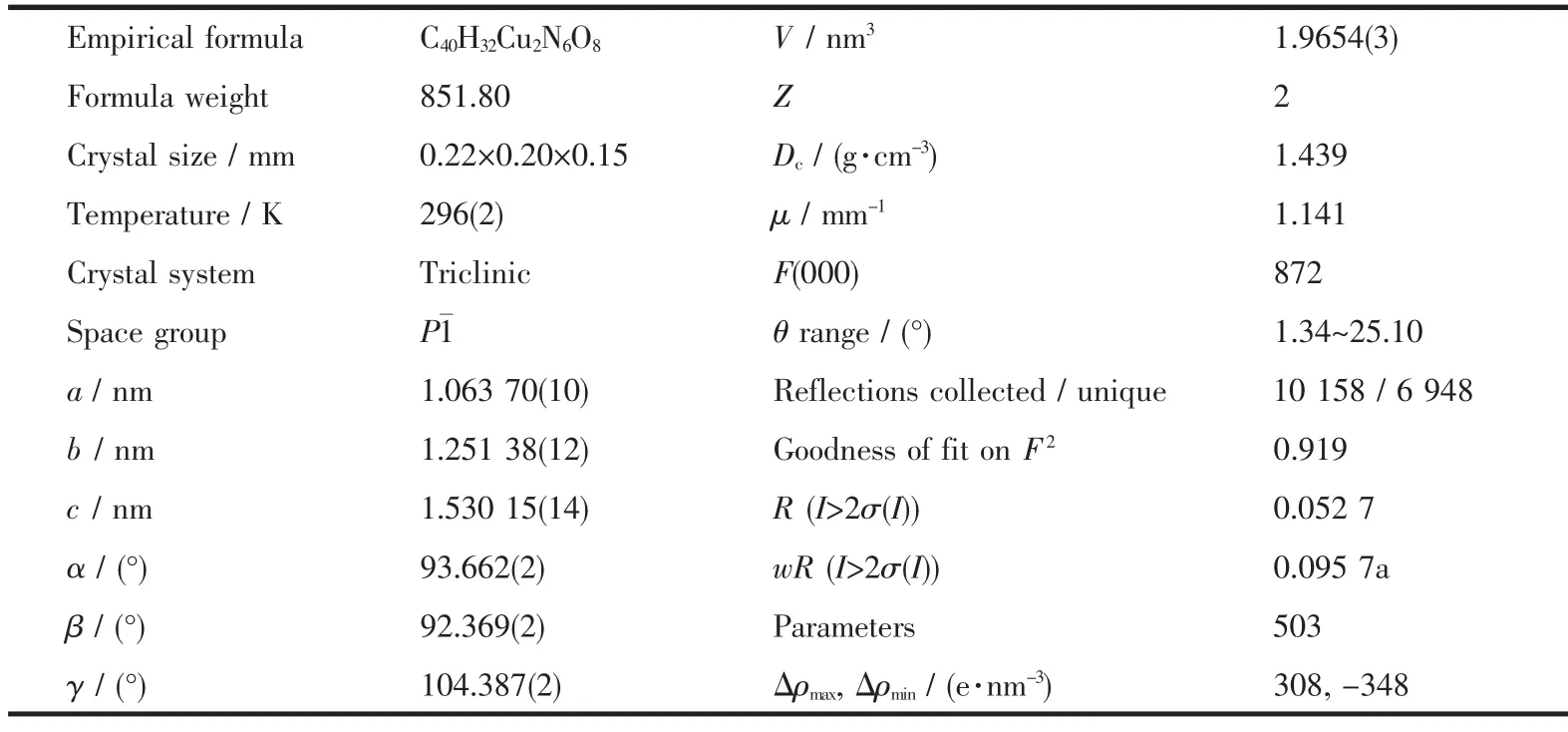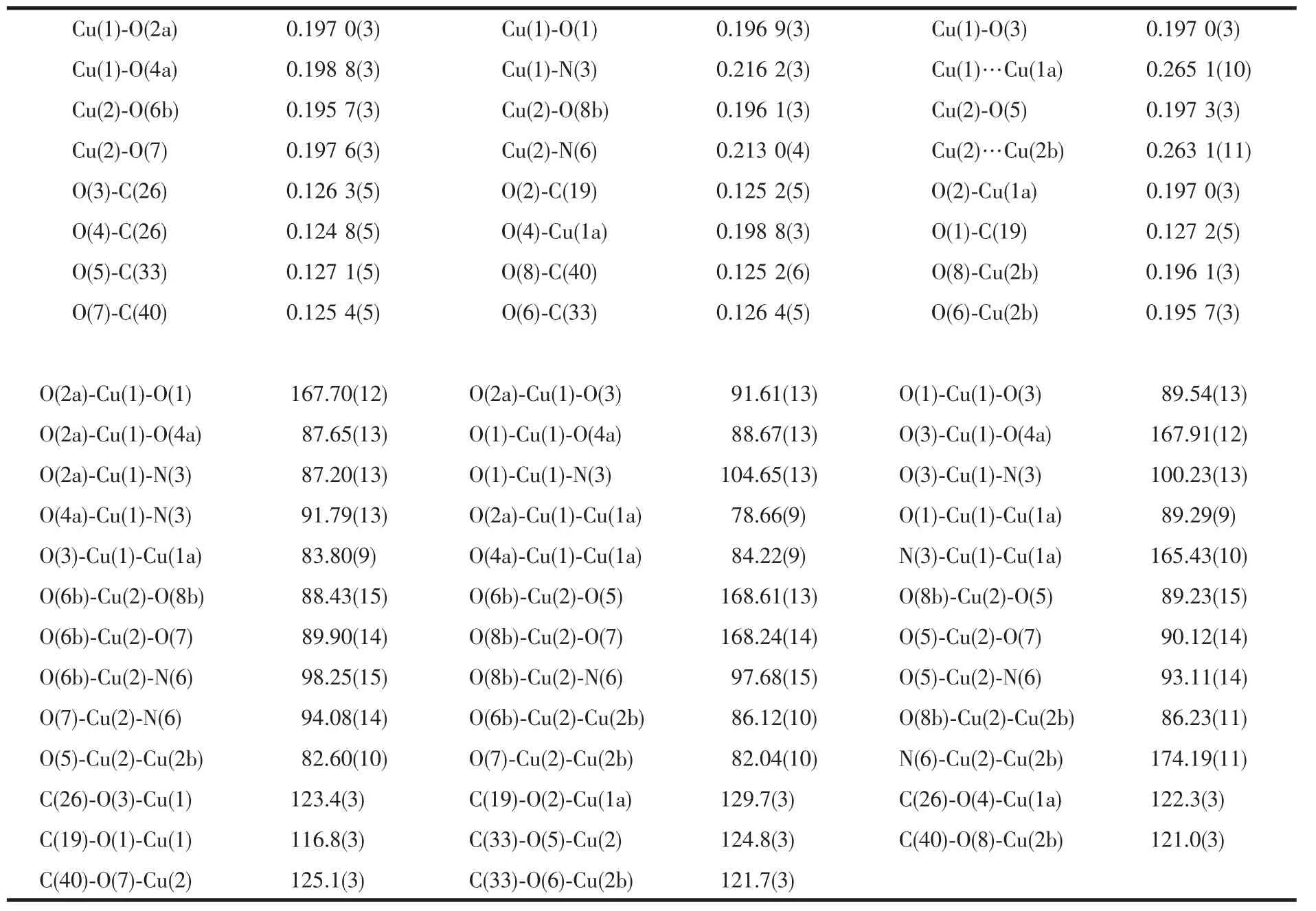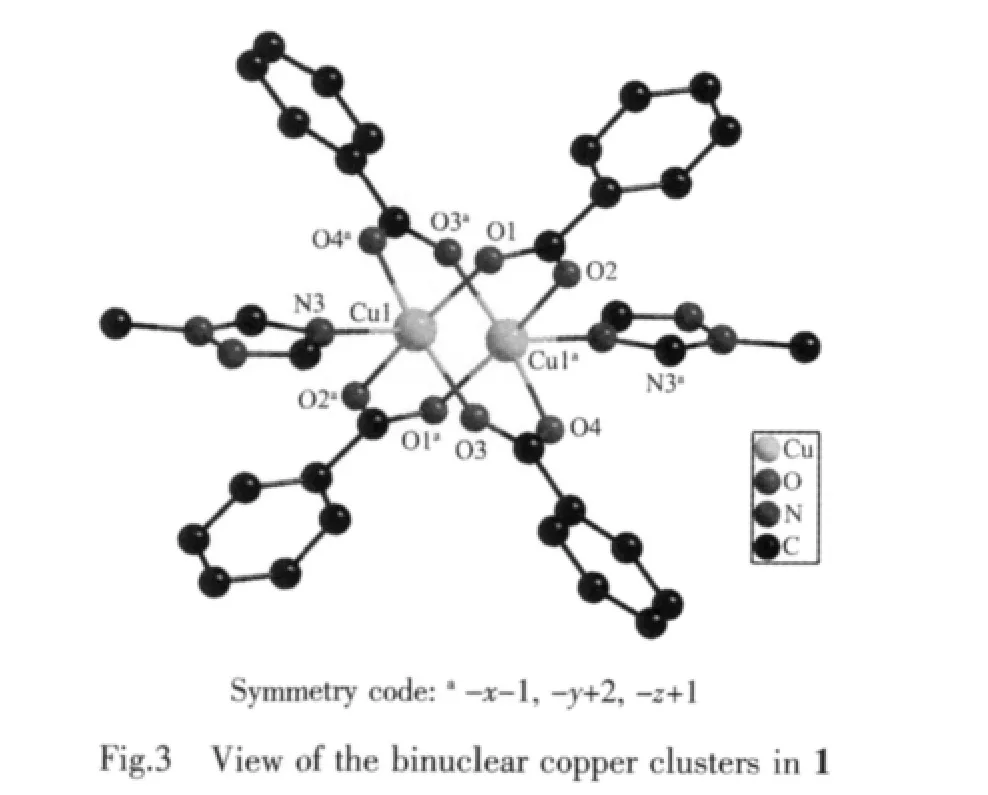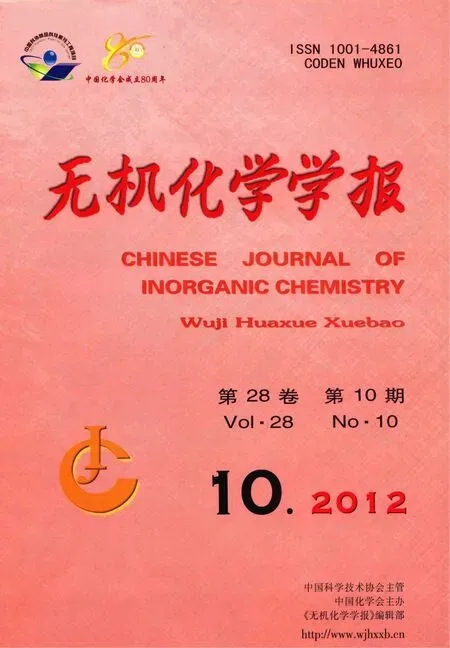由双核铜簇与柔性双三氮唑基配体构筑的一维链状铜配合物的合成、结构与光学性质表征
杜晓迪李春阳常加忠王振领
(1周口师范学院化学系,周口 466001)
(2周口师范学院物理系,周口 466001)
由双核铜簇与柔性双三氮唑基配体构筑的一维链状铜配合物的合成、结构与光学性质表征
杜晓迪*,1李春阳2常加忠2王振领*,1
(1周口师范学院化学系,周口 466001)
(2周口师范学院物理系,周口 466001)
基于柔性的双三氮唑基配体和刚性的芳香羧酸,合成得到了一个一维链状铜配位聚合物[Cu2(bza)4(btx)]n(1)(btx=1,4-二(1,2,4-三唑基-1-基甲基)苯,Hbza=苯甲酸),并通过元素分析、红外光谱、X-射线单晶衍射、热分析、荧光光谱等测试对其进行了表征。晶体数据表明该化合物属于三斜晶系,P1空间群。在化合物1中,羧酸根均采取双齿桥联的模式,4个苯甲酸配体螯合2个铜离子构成1个双核铜单元 (Cu-Cu键的距离为0.26 nm),这些双核铜单元又通过柔性双三氮唑基配体桥联形成一维链状的结构;热分析表明该化合物具有相对较高的热稳定性,室温下的固态荧光测试发现,在398 nm激发下,化合物1发射出绿色光。
链状聚合物;刚性配体;柔性双三氮唑基配体;晶体结构
Design and synthesis of metal-organic coordination polymers have been achieving rapidly increasing attention because oftheirintriguing variety of architectures,topologies,and potential applications as functional materials[1-3].Versatile synthetic approaches for the assembly of target structures have been developed.In 2003,Yaghi has put forward the Reticular synthesis,which shown that the design of an extended network can be realized by starting with well-defined and rigid molecular building blocks that will maintain their structural integrity throughout the construction process[4-6].The key to success is the design of the molecular building blocks which direct the formation of the desired architectural,chemical,and physical properties of the resulting solid-state materials.So the polycarboxylates are good candidate to construct the secondary building units(SBUs).Additionally,in contrast to the bond of metal-N,the bond metal-O is more stable,which may result more thermal stable framework[7].Up to now,a large number of coordination polymers based on the multicarboxyl ligands have been obtained,which exhibitthe diversified structural topologies and the interesting applications as functional materials in porosity,magnetism,optics,etc[8-11].Among the organic carboxylate acid,the structure of benzoic acid is the most simple,so the influence of the controllable synthesis for the target framework may be observed more directly and more clearly,which may provide the clear and direct material for the future research.
Another important branch in this field is the metal-organic frameworks (MOFs)based on the N-heterocycle ligands,such aspyridine,imidazole,trizole and tetrazole etc,which have strong metal binding capability and versatile coordination modes[12-14].Recently,the introduction of the flexible ligands has become more popular.For example,flexiblebis(pyridine)[15],bis(imidazole)[16],bis(triazole)[17],and bis(tetrazole)[18]ligands have been exploited to construct MOFs with interesting architectures and functions.The flexibility and conformational freedom of such flexible ligandsallow them to conform to the environment of the metal ions or inorganic building blocks, providing the possibility to construct unprecedented frameworks with interesting structures and properties[19].Among the flexible pyridinyl ligands,1,4-bis (1,2,4-triazol-1-ylmethyl)benzene (btx) is especially interesting with respect to the following considerations:(i)The bis(triazole)ligand combine the coordination geometry of both imidazoles and pyrazoles to provide more potential coordination sites;(ii)The ligand can act as bridges to construct high dimensional framework.These characteristics may result the construction of diversified attractive frameworks[20].Herein,by utilizing benzoic acid and flexible bis(triazole)ligand to construct the secondary building units and extending the dimensional of the framework,especially,the new one dimensional coordination polymer[Cu2(bza)4(btx)]n(1)(btx=1,4-bis(1,2,4-triazol-1-ylmethyl)benzene,Hbza=benzoic acid)based on the binuclearcopperunitshasbeen successfully prepared and characterized in this paper.The thermal analysis and luminescent measurement for the compound was also performed.
1 Experimental
1.1 Materials and general methods
1,4-bis(1,2,4-triazol-1-ylmethyl)benzene(btx)was synthesized according to the literature method[21].All other reagents were of analytical grade and used as obtained from commercial sources without further purification.Elemental analyses for C,H and N were performed on a Perkin-Elmer 240C analyzer.Infrared spectra were recorded on a Nicolet 6700 Spectrophotometer with KBr pellets in the 400~4 000 cm-1region.The powder XRD patterns were recorded on a Bruker D8 X-ray diffractometer.Thermal analyses(TGA)were collected on a PerkinElmer STA6000 TGA analyzer from room temperature to 700℃with a heating rate of 20 ℃·min-1under nitrogen.Steady state fluorescence measurementswere performed using spectrofluorimeter PerkinElmer LS55 atambient temperature in solid state.
1.2 Synthesis of[Cu2(bza)4(btx)]n(1)
A mixture of btx(0.2 mmol,42 mg),benzoic acid(0.6 mmol,73 mg),Cu(NO3)2·3H2O(1 mmol,250 mg)and H2O(12 mL)was sealed in a 25 mL Teflon-lined bomb and heated at 155 ℃ for 3 d.The reaction mixture was slowly cooled to room temperature.Green block crystals of 1 suitable for X-ray diffraction analysis were isolated in 63%yield.Anal.Calcd.for C40H32Cu2N6O8(%):C,56.40;H,3.79;N,9.87.Found(%):C,56.50;H,3.91;N,9.94.IR(KBr,cm-1):3140(s),3061(s),1628(s),1572(s),1519(m),1493(w),1 405(s),1 280(m),1 198(w),1 175(m),1 130(s),1 068(w),1 018(w),985(w),844(w),771(w),702(s),685(s),485(s),444(s).

Table 1 Crystallographic data for complex 1

Table 2 Selected bond lengths(nm)and angles(°)for complex 1
1.3 X-ray crystallography
A single crystal of 1 with dimensions of 0.22 mm ×0.20 mm ×0.15 mm was mounted on a BrukerSmart Apex CCD diffractometer equipped with a graphite-monochromatic Mo Kα radiation(λ=0.071 073 nm)radiation using the φ-ω scan mode in the range 1.34°≤θ≤25.10°at 296(2)K.A total of 10 158 reflections were collected and 6 948 were independent with Rint=0.042 4,of which 3 859 were observed with I>2σ(I).Raw frame data were integrated with the SAINT program[22].The structure was solved by direct methods and refined by full-matrix least-squares on F2using SHELX-97[23].An empirical absorption correction was applied with the program SADABS[24].All nonhydrogen atoms were refined anisotropically.All the hydrogen atoms were set in calculated positions and refined by a riding mode,with a common thermal parameter.Crystallographic details have been summarized in Table 1.Selected bond lengths and angles for 1 are listed in Table 2.
CCDC:854824.
2 Results and discussion
2.1 Syntheses,IR spectroscopy,and X-ray powder diffraction
Compound 1 was obtained under the hydrothermal condition.It is stable in air and in common solvent.The IR spectrum of 1 displays the characteristic vibration peaks of carboxylate groups for the asymmetric vibration (1 628 cm-1)and symmetric(1 405 cm-1)[25-26],while the absence of the characteristic bands of the carboxylic acid at around 1 690~1 730 cm-1,indicates the complete deprotonation of the benzoic acid,which is consistent with the results of the X-ray analysis.The absorption bands at 1 572~1 493 cm-1can be attributed to the characteristic vibrations of the aromatic rings in the carboxyl and pyridyl ligands.In addition, the less strong characterized bands for the aromatic rings in these ligands under 900 cm-1(the out-of-plane motion of the C-H groups of the aromatic rings)were also observed.These bands at 844,720 and 685 cm-1indicate that there are two and five consecutive hydrogen atoms in the aromatic rings, respectively[26],which further improved that the existence of these two kinds of ligands in compound 1.
In the PXRD patterns for compound 1(Fig.1),the diffraction peaks of both simulated and experimental patterns match well at the relevant positions,indicating the phase purities of 1.The difference in reflection intensities between the simulated and experimental patterns is due to the preferred orientation of the crystals in the powder sample.

2.2 Structural description

Single-crystal X-ray structural analysis showed that compound 1 crystallizes in the triclinic space group P1.The asymmetric unit of 1 (Fig.2)contains two crystallographically unique Cu2+ions,four bzaligands and one btx ligand.The Cu(1)ion is fivecoordinated by four oxygen atoms(O(1),O(3),O(2a)and O(4a))from four bza-ligands and one nitrogen atom(N(3))from the btx ligand(Symmetry code:a-x-1,-y+2,-z+1).All the bza-ligands are full deprotonated and act as bidentate ligands binding two Cu atoms adopting the syn-syn coordination mode.Then the same four bza-ligands connect the neighboring two copper ions(Cu(1)and Cu(1a))in a chelating coordinated mode to form a binuclear copper unit(Fig.3)with the Cu-Cu distance of 0.265 nm.Thecoordination mode of Cu(2)is similar to Cu(1),and two neighboring copper ions(Cu(2)and Cu(2b))were also chelated by another four bza ligands to form the similarbinuclearcopperunits with the Cu-Cu distance of 0.263 nm (Symmetry code:b-x+1,-y+1,-z).The coordination geometry around the copper ions can be described as slightly distorted tetrahedra with four oxygen atoms located in the equatorial plane and nitrogen atom occupy the apical positions.The Cu-N bond lengths(0.213 0(4)~0.216 2(3)nm)and Cu-O bond lengths(0.195 7(3)~0.198 8(3)nm)all fall in the regular range[27-28].Each btx ligand utilizes its two apical N atoms as a bidentate linker to bridge two Cu ions,showing the trans-trans conformation.So the neighboring binuclear copper clusters are further linked by the bidentate bridging ligands (btx)generating the infinite one dimensional chains(Fig.4)with the distance of the neighboring binuclear copper units about 1.564 nm.


2.3 Thermal property
Thermal analyses(TG-DTA)has been measured for complex 1.As shown in Fig.5,complex 1 shows a continuous weight loss of 84.73% (calcd.85.08%)in the 33~700 ℃,which can be attributed to the combustion of all the organic ligands in 1.In the corresponding DTA curve,there is a strong endothermal peak at 260℃,resulting from the removal of coordination organic groups in compound 1.The exothermal peak observed at 579℃in the DTA curve indicates the collapse of the skeleton whole framework.All the data above illustrate that compound 1 retains a comparatively good thermal stability.

2.4 Fluorescent property
Photoluminescent properties of complex 1 and the free ligands were investigated in the solid-state at room temperature.Both ligands btx and Hbza display strong fluorescence emission.Btx is a conjugated organic compound which gives a strong fluorescent emission at470 nm when excited at395 nm.Compared with fluorescent emission resulting from p*-p transition of btx,that of the p*-n transition of bzais much weaker.As strong electron withdrawing groups,carboxylate ligands almost have no contribution to the fluorescent emission[29-31].Complex 1 shows strong fluorescent emissions with a maximum at 530 nm (Fig.6),at λex=398 nm.Therefore,emission bands in 1 can be attributed to the emission of ligand-to-metal charge transfer(LMCT),which has been found in some reported copper coordination polymers[32-33].The emission in the green region suggests that the complex may be potential green-light emitting materials,which is rarely observed in the copper coordination complexes.

3 Conclusions
In this paper,by introducing both the simple rigid ligand(benzoic acid)and flexible bis(triazole)ligand(btx)into the coordination system,a new one dimensional chainlike coordination polymer was obtained.In this complex,all the carboxylate ligands adopt the bidentate bridging mode binding two Cu atoms,and four bza-ligands connect the neighboring two copper ions in a chelating coordinated mode to form a binuclear copper unit(dCu-Cu=0.26 nm).Then the neighboring binuclear copper units are further linked by the flexible bis(triazole)ligands to extend the whole framework forming infinite one dimensional chains.The thermal analysis illustrate that compound 1 retains a comparatively good thermal stability and the luminescent spectra shows that complex 1 shows strong green fluorescent emission when excited at 398 nm.
[1]Batten S R,Robson R.Angew.Chem.,Int.Ed.,1998,37:1460-1494
[2]Carlucci L,Ciani G,Proserpio D M.Coord.Chem.Rev.,2003,246:247-289
[3]Guo H,Zhu G,Hewitt I J,et al.J.Am.Chem.Soc.,2009,131:1646-1647
[4]Yaghi O M,O′Keeffe M,Ockwig N W,et al.Nature,2003,423:705-714
[5]Yaghi O M,Li H,Davis C,et al.Acc.Chem.Res.,1998,31:474-484
[6]Eddaoudi M,Moler D B,Li H L,et al.Acc.Chem.Res.,2001,34:319-330
[7]Li H,Eddaoudi M,Groy T L,et al.J.Am.Chem.Soc.,1998,120:8571-8572
[8]Liu Y,Eubank J F,Cairns A J,et al.Angew.Chem.Int.Ed.,2007,46:3278-3283
[9]YANG Ying-Qun(杨颖群),LI Chang-Hong(李昶红),LI Wei(李薇),et al.Chinese J.Inorg.Chem.(Wuji Huaxue Xuebao),2009,25(4):730-733
[10]Zhao X,Xiao B,Fletcher A J,et al.Science,2004,306:1012-1015
[11]Wang X Y,Sevov S C.Inorg.Chem.,2008,47:1037-1043
[12]Alexeev Y E,Kharisov B I,Hernandez Garcia T C,et al.Coord.Chem.Rev.,2010,254:794-831
[13]Verma S,Mishra A K,Kumar J.Acc.Chem.Res.,2010,43:79-91
[14]Liu D S,Huang G S,Huang C C,et al.Cryst.Growth Des.,2009,9:5117-5127
[15]Ma L F,Wang L Y,Wang Y Y,et al.Inorg.Chem.,2009,48:915-924
[16]Zhang E P,Hou H W,Han H Y,et al.J.Organomet.Chem.,2008,693:1927-1937
[17]Gu Z G,Xu Y F,Zhou X H,et al.Cryst.Growth Des.,2008,8:1306-1312
[18]Bronisz R.Inorg.Chem.,2007,46:6733-6739
[19]He H Y,Collins D,Dai F N,et al.Cryst.Growth Des.,2010,10:895-902
[20]Yu R M,Kuang X F,Wu X Y,et al.Coord.Chem.Rev.,2009,253:2872-2890
[21]Torres J,Lavandera J L,Cabildo P,et al.Heterocyc.Chem.,1988,25:771-782
[22]SAINT,Area Detector Control and Integration Software,Siemens Analytiacl X-ray Instruments Inc.,Madison,WI,USA,1996.
[23]Sheldrick G M.SHELX97,Program for X-ray Crystal Structure Solution and Refinement,University of Göttingen,Germany,1997.
[24]Sheldrick G M.SADABS,Program for Empirical Absorption Correction of Area Detector Data,University of Göttingen,Germany,1996.
[25]Bellamy L J.The Infrared Spectra of Complex Molecules.New York:John Wiley&Sons,1958.
[26]Williams D H,Fleming I.Spectroscopic Methods in Organic Chemistry.Cambridge:McGraw-Hill,1995.
[27]Kessissoglou D P,Raptopoulou C P,Bakalbassis E G,et al.Inorg.Chem.,1992,31:4339-4345
[28]Lu J J,Xu Y,Goh N K,et al.Chem.Commun.,1998:2733-2734
[29]Gong Y,Liu J Z,Hu C W,et al.Inorg.Chem.Commun.,2007,10:575-579
[30]Chen Q,Chen S C,Xiao B,et al.Inorg.Chem.Commun.,2008,11:1371-1374
[31]Gu Z G,Li G Z,Yin P Y,et al.Inorg.Chem.Commun.,2011,14:1479-1484
[32]Shi X,Zhu G,Fang Q,et al.Eur.J.Inorg.Chem.,2004:185-191
[33]Chen W,Wang J,Chen C,et al.Inorg.Chem.,2003,42:944-946
One Dimensional Chainlike Coordination Polymer Constructed from Binuclear Copper Clusters Linked by Flexible Bis(triazole)Ligands:Synthesis,Structure and Luminescent Property
DU Xiao-Di*,1LI Chun-Yang2CHANG Jia-Zhong2WANG Zhen-Ling*,1
(1Department of Chemistry,Zhoukou Normal University,Zhoukou,Henan 466001,China)
(2Department of Physics,Zhoukou Normal University,Zhoukou,Henan 466001,China)
A one dimensional chainlike copper coordination polymer[Cu2(bza)4(btx)]n(1)(btx=1,4-bis(1,2,4-triazol-1-ylmethyl)benzene,Hbza=benzoic acid)based on binuclear copper units and the flexible bis(triazole)ligands has been synthesized and characterized by element analysis,IR spectra,single-crystal X-ray diffraction,thermal analysis,luminescent property.The crystallographic data shows that complex 1 crystallizes in triclinic space group P1 with a=1.063 70(10)nm,b=1.251 38(12)nm,c=1.530 15(14)nm, α=93.662(2)°, β=92.369(2)°, γ=104.387(2)°,V=1.965 4(3)nm3,C40H32Cu2N6O8,Mr=851.80,Dc=1.439 g·cm-3,μ(Mo Kα)=1.141 mm-1,F(000)=872,GOF=0.919,Z=2,the final R1=0.052 7 and wR2=0.095 7 for I>2σ(I).In 1,all the carboxylate ligands adopt the bidentate bridging mode binding two Cu atoms,and four bza-ligands connect the neighboring two copper ions in a chelating coordinated mode to form a binuclear copper cluster(d(Cu-Cu)=0.26 nm).Then the neighboring binuclear copper clusters are further linked by the flexible bis(triazole)ligands generating the infinite one dimensional chains.The thermal analysis illustrate that compound 1 retains a comparatively good thermal stability and the luminescent spectrum shows that complex 1 shows strong fluorescent emission with a maximum at 530 nm at λex=398 nm.CCDC:854824.
chainlike polymer;rigid ligand;flexible bis(triazole)ligand;crystal structure
O614.121
A
1001-4861(2012)10-2223-06
2011-11-24。收修改稿日期:2012-07-29。
国家自然科学基金(No.21171179),河南省自然科学基金(No.112300410291),河南省教育厅自然科学基金(No.2011B140025,12A150028,12A140017)以及周口师范学院博士启动基金资助项目。
*通讯联系人。E-mail:duxiaodi2000@163.com,wangzhenling@zknu.edu.cn

